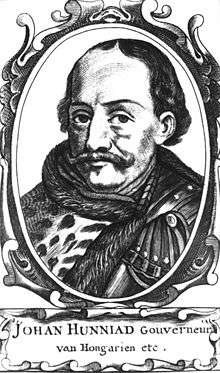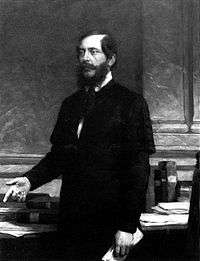Regent of Hungary
| Regent of Hungary
Former Regency | |
|---|---|
|
| |
 | |
| Style | His Serene Highness |
| Residence | Buda Castle |
| Appointer | Royal Diet |
| Term length | No fixed term |
| Formation | 1 March 1920 |
| First holder | Miklós Horthy |
| Final holder | Miklós Horthy |
| Abolished | 15 October 1944 |
The Regent of Hungary was a position established in 1920 and held by Miklós Horthy until 1944.
History of the position
Historical examples
John Hunyadi

On the untimely death of Albert in 1439, Hunyadi was of the volition that Hungary was best served by a warrior king and lent his support to the candidature of young King of Poland Władysław III of Varna in 1440, and thus came into collision with the powerful magnate Ulrich II of Celje, the chief proponent of Albert's widow Elisabeth of Bohemia (1409–1442) and her infant son, Ladislaus Posthumus of Bohemia and Hungary. Featuring prominently in the brief ensuing civil war, Władysław III's side was thus reinforced by Hunyadi's noticeable military abilities, and was rewarded by Władysław with the captaincy of the fortress of Belgrade, a latter dignity that he shared with Mihály Újlaki.
At the diet which met in February 1445 a provisional government consisting of five Captain Generals was formed, with Hunyadi receiving Transylvania and four counties bordering on the Tisza, called the Partium or Körösvidék, to rule. As the anarchy resulting from the division became unmanageable, Hunyadi was elected regent of Hungary (Regni Gubernator) on 5 June 1446 in the name of Ladislaus V and given the powers of a regent. His first act as regent was to proceed against the German king Frederick III, who refused to release Ladislaus V. After ravaging Styria, Carinthia, and Carniola and threatening Vienna, Hunyadi's difficulties elsewhere compelled him to make a truce with Frederick for two years.
Michael Szilágyi

On 20 January 1458, Matthias (son of John Hunyadi) was elected king by the Parliament. This was the first time in the medieval Hungarian kingdom that a member of the nobility, without dynastic ancestry and relationship, mounted the royal throne. Such an election upset the usual course of dynastic succession in the age. In the Czech and Hungarian states they heralded a new judiciary era in Europe, characterized by the absolute supremacy of the Parliament, (dietal system) and a tendency to centralization. During his reign, Matthias reduced the power of the feudal lords, and ruled instead with a cadre of talented and highly educated individuals, chosen for their abilities rather than their social status. The Diet appointed Mihály Szilágyi, the new king's uncle as regent, because of Matthias' young age. Throughout 1458 the struggle between the young king and the magnates, reinforced by Matthias's own uncle and guardian Szilágyi, was acute. But Matthias, who began by deposing Garai and dismissing Szilágyi, and then proceeded to levy a tax, without the consent of the Diet, in order to hire mercenaries, easily prevailed.
Lajos Kossuth

During the Hungarian Revolution of 1848 the new Emperor Francis Joseph revoked all the concessions granted in March and outlawed Kossuth and the Hungarian government - set up lawfully on the basis of the April laws. In April 1849, when the Hungarians had won many successes, after sounding the army, Lajos Kossuth issued the celebrated Hungarian Declaration of Independence, in which he declared that "the house of Habsburg-Lorraine, perjured in the sight of God and man, had forfeited the Hungarian throne." It was a step characteristic of his love for extreme and dramatic action, but it added to the dissensions between him and those who wished only for autonomy under the old dynasty, and his enemies did not scruple to accuse him of aiming for Kingship. The dethronement also made any compromise with the Habsburgs practically impossible. Lajos Kossuth became head of state as Governor-President of Hungary.
After WW1
Upon the dissolution and break-up of Austria-Hungary after World War I, the Hungarian Democratic Republic and then the Hungarian Soviet Republic were briefly proclaimed in 1918 and 1919, respectively. The short-lived communist government of Béla Kun launched what was known as the "Red Terror", involving Hungary in an ill-fated war with Romania. In 1920, the country fell into a period of civil conflict, with Hungarian anti-communists and monarchists violently purging the nation of communists, leftist intellectuals, and others whom they felt threatened by, especially Jews. This period was known as the "White Terror". In 1920, after the pullout of the last of the Romanian occupation forces, the Kingdom of Hungary was restored.
On 1 March 1920, the National Assembly of Hungary re-established the Kingdom of Hungary, but chose not to recall the deposed King Charles IV (Karoly IV of Hungary) from exile as the return of the Habsburg Emperor on the Hungarian throne was unacceptable to the Entente powers. Instead, with National Army officers controlling the parliament building, the assembly voted to install Horthy as head of state; he defeated Count Albert Apponyi by a vote of 131 to 7 and became the new Regent of Hungary.
Bishop Ottokár Prohászka then led a small delegation to meet Horthy, announcing, “Hungary’s Parliament has elected you Regent! Would it please you to accept the office of Regent of Hungary?” To their astonishment, Horthy declined unless his powers were expanded. As Horthy stalled, the politicians folded, and granted him "the general prerogatives of the King, with the exception of the right to name titles of nobility and of the patronage of the Church." Those prerogatives included the power to appoint and dismiss prime ministers, to convene and dissolve parliament, and to command the armed forces. With those sweeping powers guaranteed, Horthy took the oath of office.[1] (Charles I did try to regain his throne twice; see Charles I of Austria's attempts to retake the throne of Hungary for more details.)
Functions
The Hungarian state was legally a kingdom, but it had no king, as the Entente powers would not have tolerated any return of the Habsburgs. The country retained its parliamentary system following the dissolution of Austria-Hungary, with a prime minister appointed as head of government. As head of state, Horthy retained significant influence through his constitutional powers and the loyalty of his ministers to the crown.[2] Although his involvement in drafting legislation was minuscule, he nevertheless had the ability to ensure that laws passed by the Hungarian parliament conformed to his political preferences.
.svg.png)